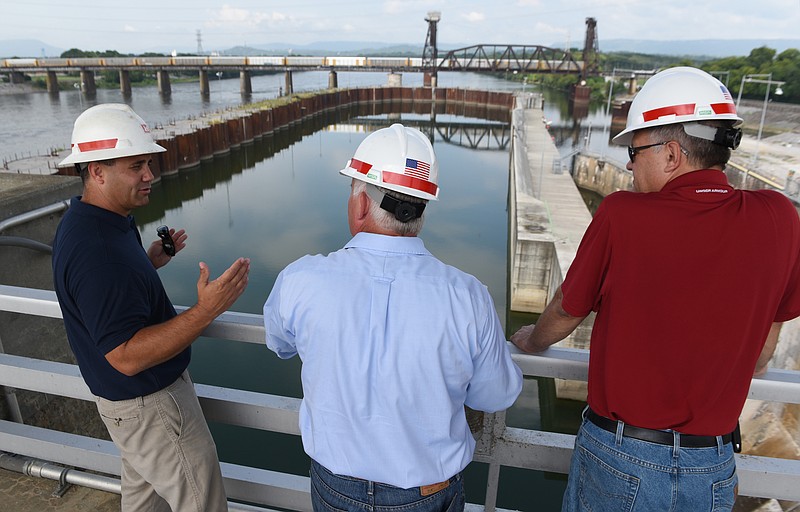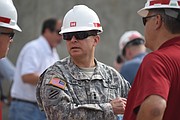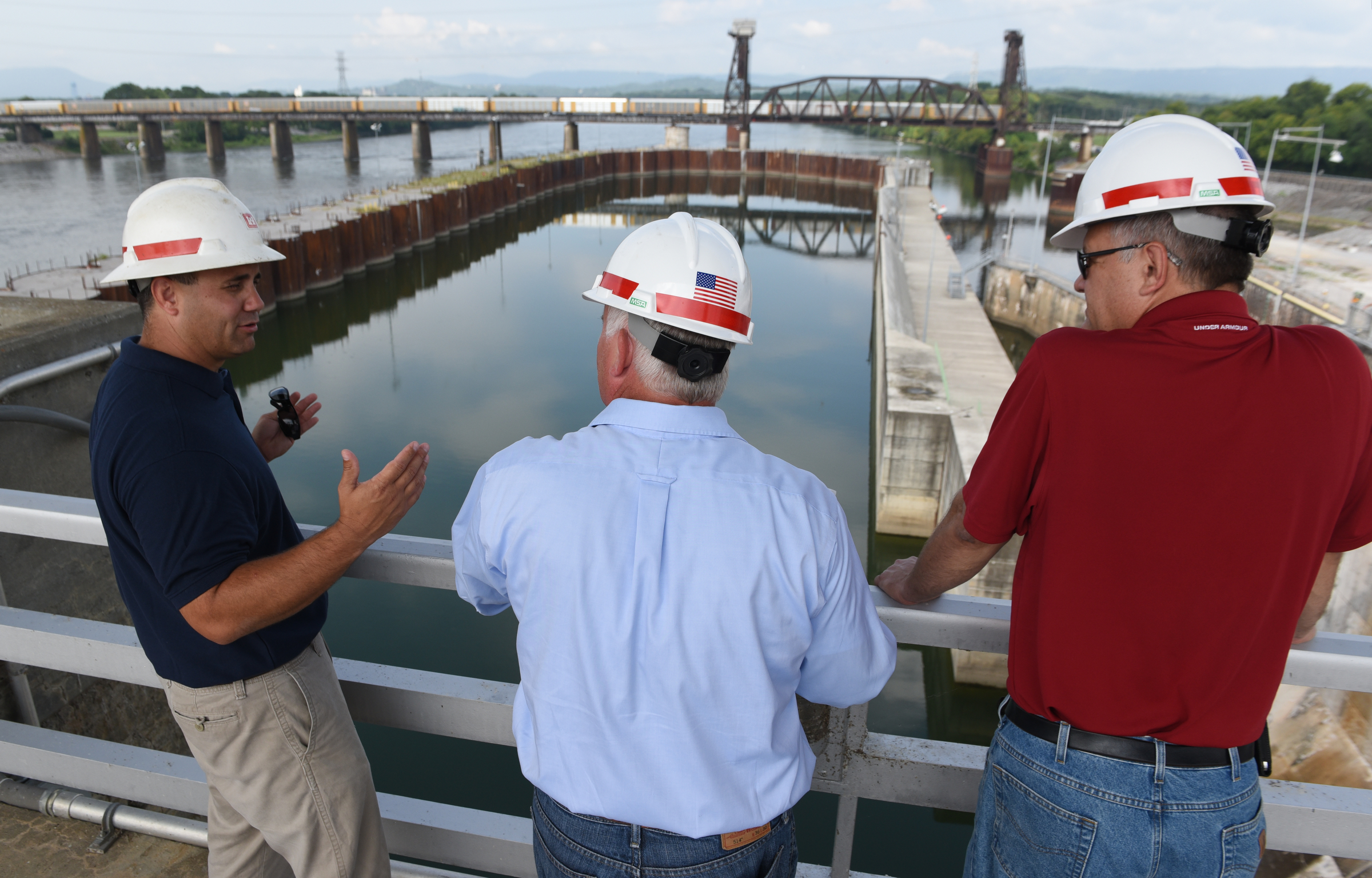Companies are reluctant to make water shipping investments because of the uncertainty [about the long-term future of the Chickamauga lock.]
The cost of building a new Chickamauga lock has more than doubled from original forecasts while barge usage of the lock has fallen by nearly 60 percent, weakening the benefit-cost ratio to a point that the project will not be included in the Obama administration's budget for next year.
By the numbers
* $858 million: Estimated cost to build a new and bigger Chickamauga Lock, up from an initial cost estimate of $310 million when the project began in 2005.* $180 million: Amount spent from 2005 to 2011 to design and start work on the new lock, which is about 20 percent complete. Completion cost is now projected at $678 million* 959,290: Tons of cargo hauled through the lock by commercial barges in 2013, down from 2.5 million at its peak in 2007.* 0.5 to 0.8: Benefit-to-cost ratio for the lock in new economic update, down from 3.0 ratio in 2009 analysis* $3 million: Amount the Corps allocated to resume construction in the current fiscal year.Source: U.S. Army Corps of Engineers
A new economic analysis of the replacement lock at the Chickamauga Dam in Chattanooga shows that the benefits of finishing the new lock may not be as great as what it is now projected to cost to build. The U.S. Army Corps of Engineers staff presented the Inland Waterways Users Board on Tuesday with projections showing that the $858 million price tag for a new and bigger lock - more than $500 million above initial estimates - may not yield enough benefits for shippers to justify further spending.
"Unfortunately, unlike some military projects, we don't fully fund lock and dam projects when they are authorized and these projects must compete for available resources each year, which tends to stretch out their completion and make them more expensive," said John Peabody, deputy commanding general for civil and emergency operations for the U.S. Army Corps of Engineers.
The Corps began work on a replacement lock at the Chickamauga Dam in 2005 when the old lock was carrying more than twice as much cargo as it does today and when the projected cost was only $310 million. But work was slowed and then ultimately halted in 2012 because of a lack of funds in the Inland Waterways Trust Fund that pays for such projects.
Similar delays have added more than $500 million to the price of building a new lock at the Olmsted Dam on the Ohio River, Peabody said, because contractors have to start and stop work and aren't able to budget for more effective construction timetables. With a $3.1 billion cost, the Olmsted lock and dam replacement has absorbed most of the available funds for inland waterway projects by the Corps.
Last year, Congress added new money for Army Corps of Engineers projects by boosting the fuel tax on barges by 9 cents a gallon and changing the funding formula to free up more Corps funds for locks and dams beyond the Olmsted project. Those extra funds helped provide the Corps with an extra $6 million of leftover funds this year - half of which has been allocated to allow the Corps to restart work at the Chickamauga lock.
Don Getty, project manager for the Chickamauga lock project, said a contract to grout cracks in the temporary coffer dam and to dewater the area will be awarded next month.
Congress also boosted the funding for the Corps in fiscal 2016 enough to provide $29 million for additional work at the Chickamauga lock, according to U.S. Sen. Lamar Alexander, R-Tenn., chairman of the Senate committee that oversees the Corps.
Alexander and other backers of the Chickamauga Lock replacement project insist that the project is worthwhile because it will keep thousands of trucks off the road, lower transportation costs in East Tennessee and help recruit more industry to the region. Because the existing 75-year-old lock suffers from problems with "concrete growth" in its rock aggregate, the lock is slowly crumbling and may have to be permanently shut down even after the Corps installed 335 post-tensioned strand anchors to help shore up the decaying lock chamber.
If the existing lock closes, 318 miles of navigable river upstream of Chattanooga, including locks at Watts Bar and Fort Loudoun, would be cut off and delivery of key equipment for nuclear facilities at Oak Ridge and Watts Bar could not be made.
Shippers also insist that the benefits from a new lock justify its expense and that a new and bigger lock should boost river traffic and cut their costs.
Olin Corp. in Charleston uses the Chickamauga lock to help deliver brine salt and other materials needed to make chlorine, caustic soda and hydrochloric acid. Tom Tirabassi, vice president of supply chain management for Olin, said having water transportation not only cuts shipping costs in its own right, but he estimates the competition lowers railroad shipping expenses by 40 percent when Olin transports products by rail.
Upstream at Tate & Lyle in Loudon, Tenn., 2 million tons of corn a year is brought to the plant. Jerry Schlueter said the company used to use the cheaper Tennessee River for corn deliveries, but uncertainties and repair outages at Chickamauga Dam caused Tate & Lyle to turn to Norfolk Southern Railroad instead, even at a higher cost.
"Companies are reluctant to make water shipping investments because of the uncertainty [about the long-term future of the Chickamauga lock]," Schlueter said.
Barge companies contend a new and bigger lock at the Chickamauga Dam will provide needed certainty and limit lock shutdowns. Chickamauga lock has been dewatered and out of service for more than three months in the past five years. That is too unreliable for Tate & Lyle, Schlueter said.
Backers of the new Chickamauga lock insist the benefits will far exceed its costs over time, especially as river shipments grow in the region and highway traffic worsens for truck traffic as an alternative. The Chickamauga lock also is one of the most actively used locks for recreational boats, carrying 1,493 boats in 2013, or 36 percent more boats than commercial barges that year.
The Corps doesn't give much allowance for the economic benefits of recreational service but that is a key asset for the region, according to Cline Jones, executive director of the Tennessee River Valley Association.
"Economic developers also will have another tool in their arsenal when the new lock is built," he said.
The Corps also has changed its cost projection formula, and Getty said the price tag for completion of the Chickamauga lock may not be as great if funding is regularly provided and the project is completed in the next eight to 10 years.
Jones said having the Inland Waterways Users Board at the Chickamauga lock Tuesday should broaden support for the project as the Corps and Congress consider inland waterway projects for the future.
Contact Dave Flessner at dflessner@timesfreepress.com or at 423-757-6340.


